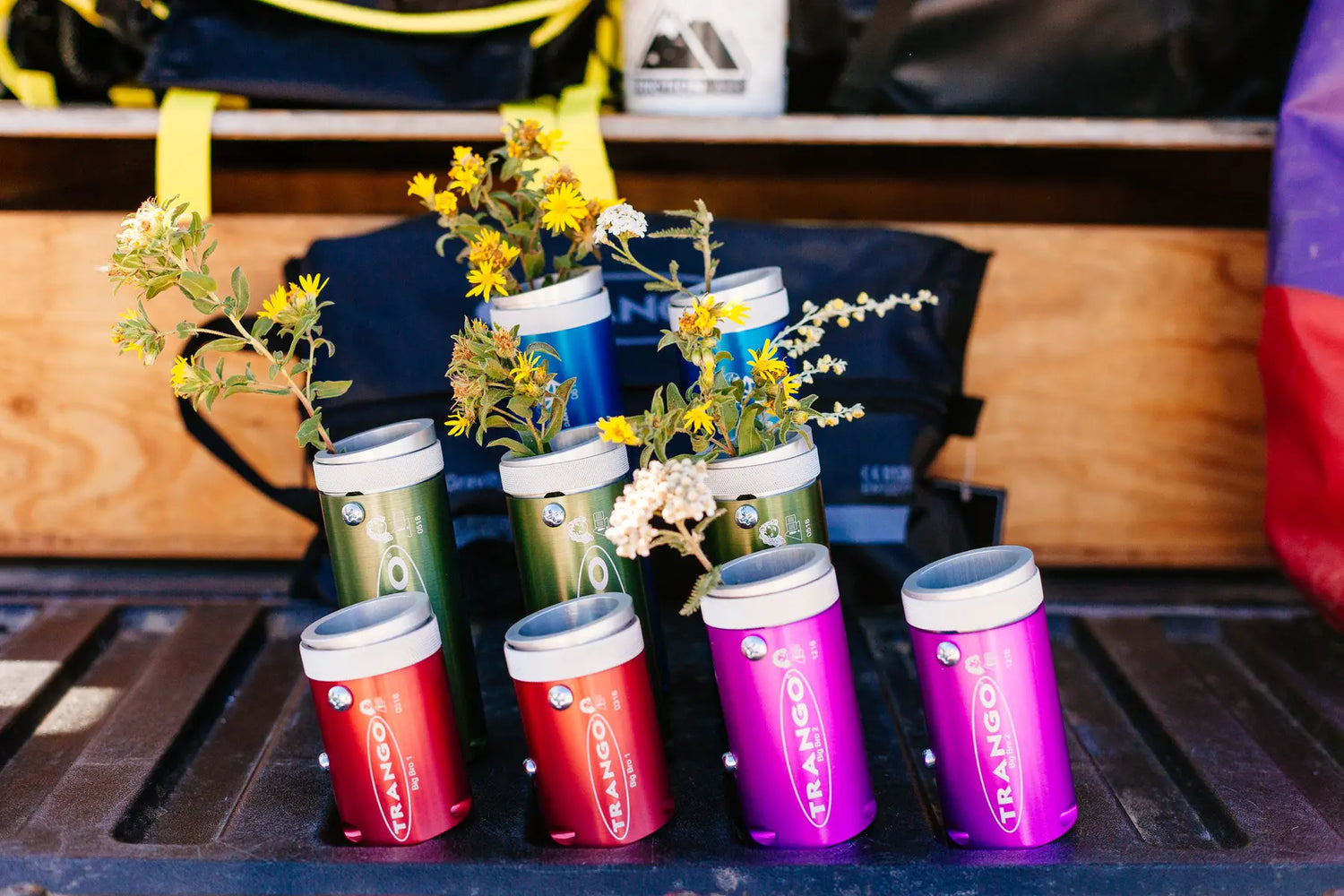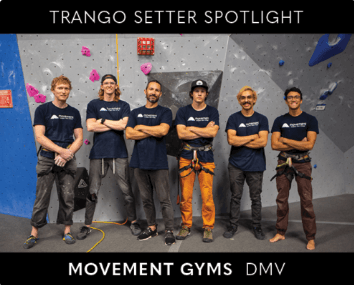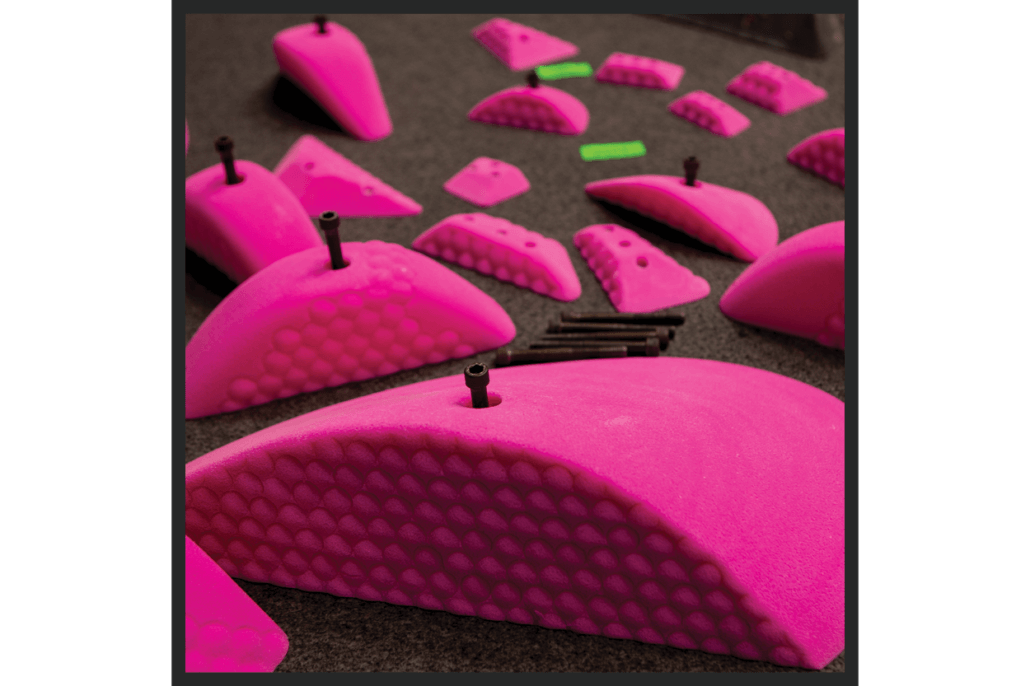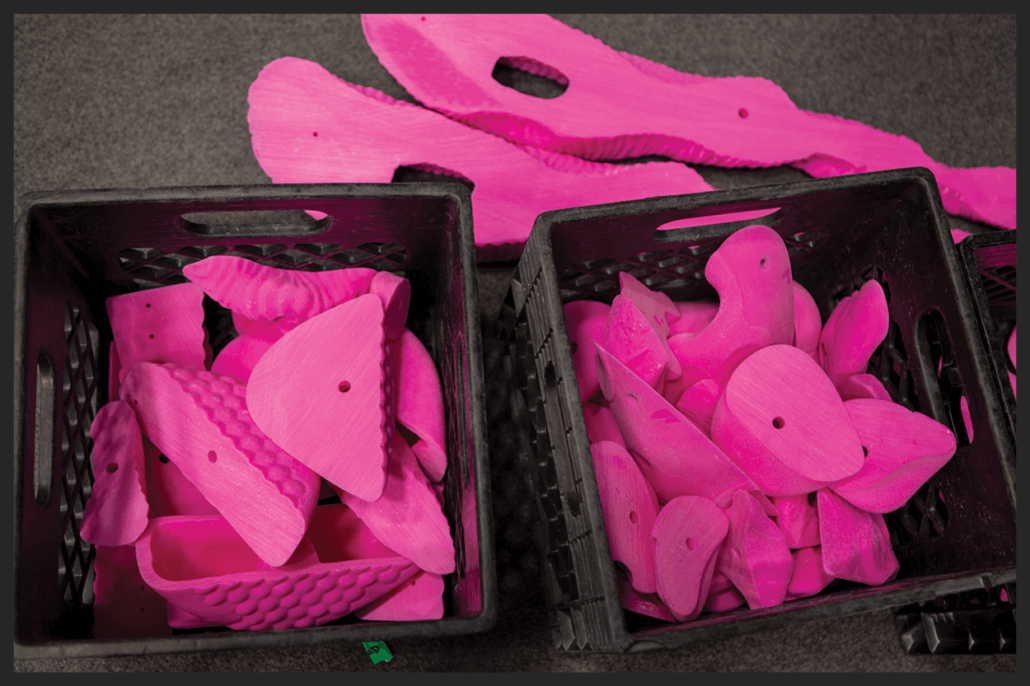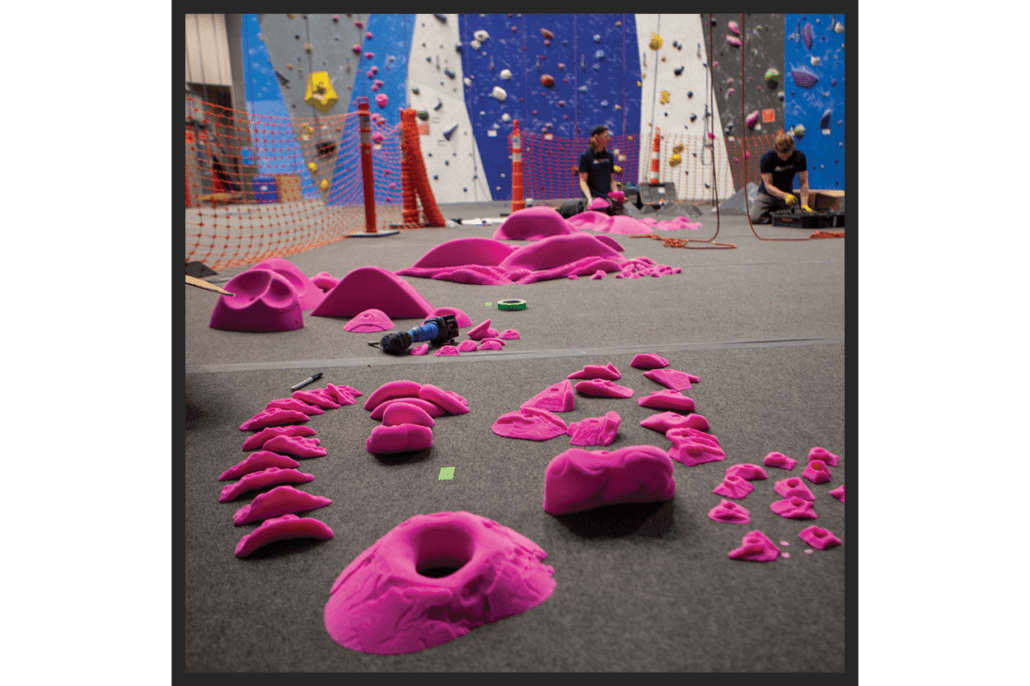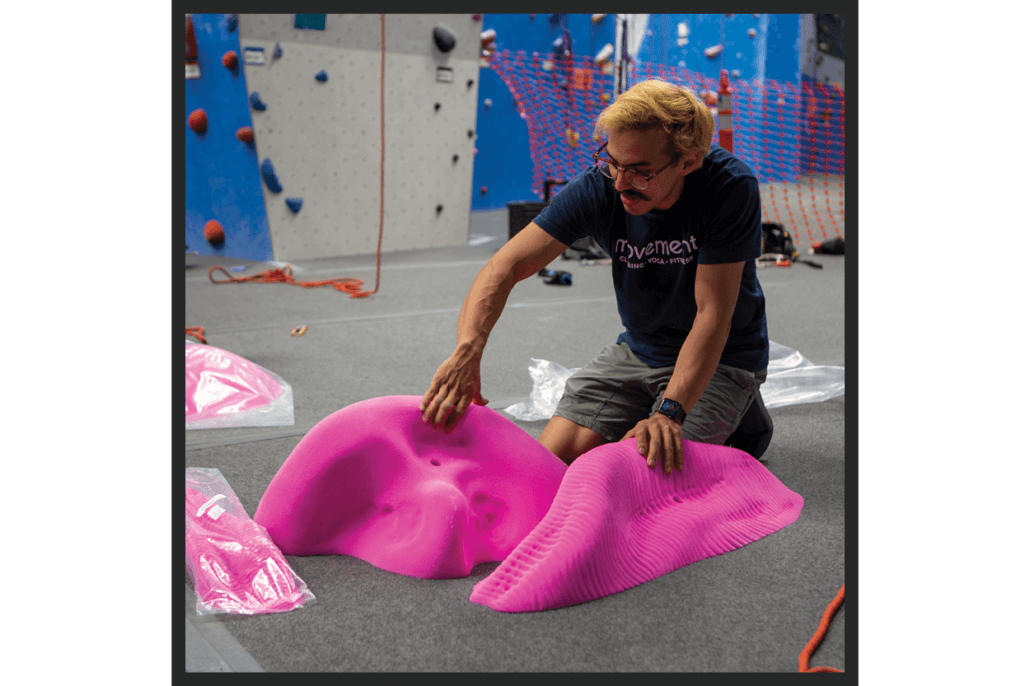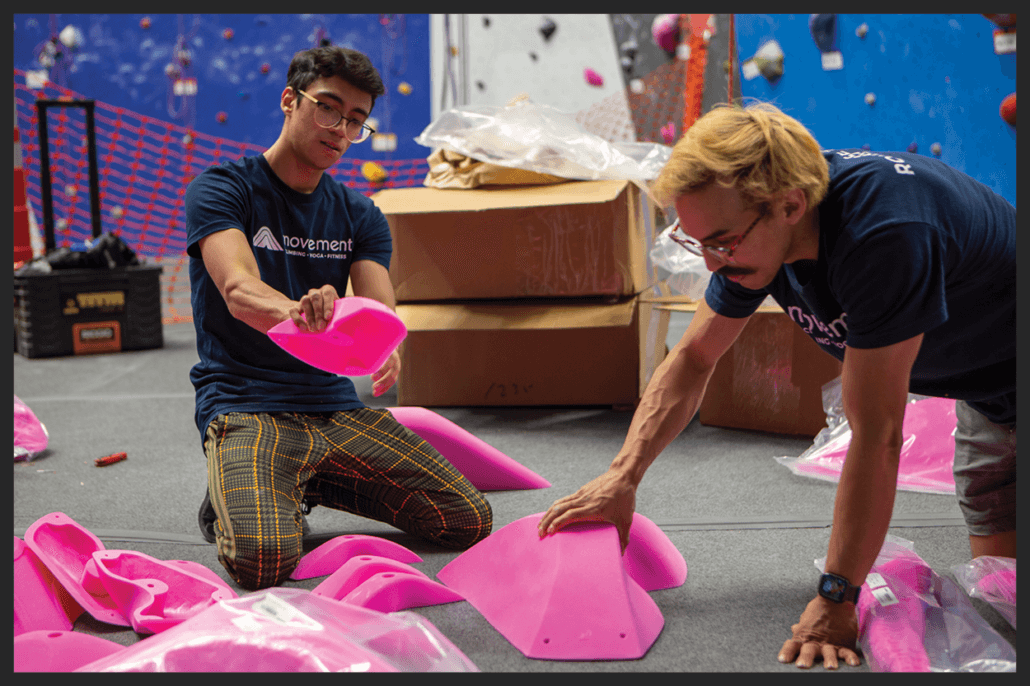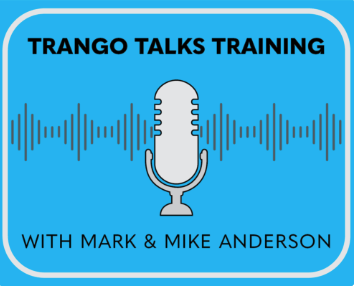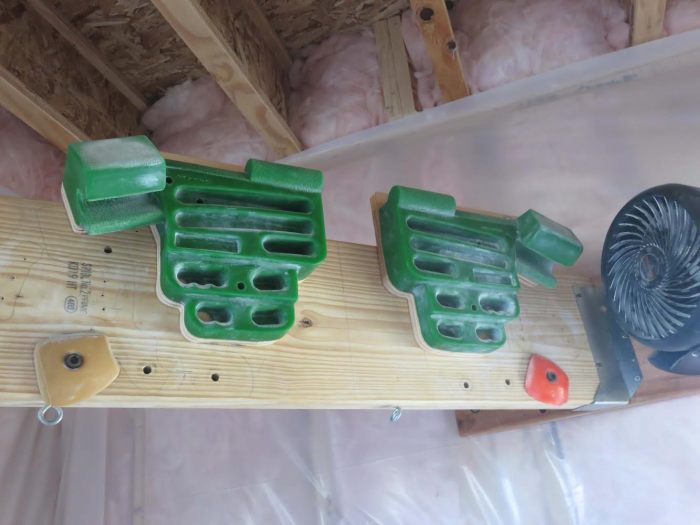From L – R: Matt Bosley, Charley Van Anda, Ward Byrum, Matthew Vesely, Chris Canela, Sammy Vasquez
For our first feature in the Setter Spotlight series, we went to visit Movement’s Crystal City location in Arlington, VA. The lead routesetters from all five of Movement’s locations in the DMV gathered to collaborate and set together as a team. The routesetters brought high energy and excitement with them, as they rarely get an opportunity to work together on a project of this scale. At the end of the day, they’d put up a long, eye-catching route that ascended the lead cave, filled with interesting movement and increasing in difficulty as the climb progressed.
Meet the Setters
Ward Byrum
Director of Routesetting – VA/MD/IL/TX
Matthew Vesely
Head Routesetter – Movement Columbia
Matt Bosley
Head Routesetter – Movement Timonium
Chris Canela
Assistant Director of Routesetting – Movement Crystal City
Sammy Vasquez
Head Routesetter – Movement Rockville
Charley Van Anda
Assistant Director of Routesetting – Movement Hampden
The Holds
For their route, the team was given their choice of any holds in our catalogue. They settled on a selection of holds from some of our most iconic styles since the inception of Trango Holds. Routesetters and climbers alike will recognize styles like Bubble Wrap and Mammoth Rub on the walls of gyms around the globe. The vision was to reflect the evolution of Trango Holds on the wall, with our earliest shapes flowing into our newest.
Bubble Wrap
Bubble Wrap Big Wave
Bubble Wrap Big Pinches
Bubble Wrap Flat Screw-Ons
Main Dish
Dish Power Pinch
Dish Dream Pockets
Myorcan Double Tufa Pinch
Myorcan Knubs
Myorcan Tufa Big Wave
Giant GeoFin
SoCo Sleeping Giant
Stealth 2Tex Shelf
Stealth 2Tex Slopers
Khan Mega Sloper Jug
Khan Crimps
Khan Sloper Jugs
eGrips Classic Home Gym Kit
The Route
Set prominently in the lead cave, the route is easily seen as one enters the roped climbing area. The route began on slightly overhanging terrain, eventually moving into a fully horizontal roof filled with large holds and volumes, demanding creative movement from the climber. Moving onto the head wall, the climber is faced with larger holds and larger moves leading up to the anchors. Winding its way up the wall, the route is about as long as it could be, requiring a great deal of endurance to complete. Looking at the entire route, it’s easy to see the evolution of trends in climbing holds from the early days with holds resembling more natural rock features to more abstract and artistic shapes of modern times.
Setting a route can be a challenging task for one routesetter, let alone six. A long 8-hour day began with dividing up the holds based on release year and divvying them up between all the setters. They used a white board to sketch out the wall and their rough vision for the route. Then, the setting began.
Matt, who has been setting with Movement Gyms for __ years, set the start of the route, using some of Trango’s most classic holds from the 90s and early 2000s: Granite Ledges, Papa Elephant, Hueco Wonder Hole, and Comfy Crimps.
From there, Ward took over with a pair of Main Dishes, the Dish Power Pinch, Dish Dream Pockets, and Drop Art Finger Buckets. The route begins to move into more overhanging terrain, with an opportunity for a kneebar rest between two large dish holds before pushing through the roof.
Matthew was up next, bringing a massive volume and the iconic Bubble Wrap style onto the wall. He impressively wrestled to secure the pyramid-shaped volume onto the 45-degree overhang wall, and placed the Bubble Wrap, Bubble Wrap Big Wave, Bubble Wrap Big Pinches, and Bubble Wrap Ledges on two of its faces, making for fun and creative movement.
At this point we’ve reached the pure horizontal roof. Charlie set his sequence through this challenging terrain with the massive Myorcan Tufu Big Wave, the Myorcan Double TufaPinch, Myorcan Tufas, and Myorcan Knubs. To close out his section, he set the SoCo Sleeping Giant on one side of a volume, the last hold as the climber moves out of the roof and onto the head wall. This large, bulbous hold could be approached and scaled in a number of ways, making for a thoughtful moment in the route.
Moving onto the head wall, climbers meet the Giant Geo Fin, which leads to a section of Stealth 2Tex Slopers flanking a giant Stealth 2Tex Shelf set by Chris. With sparse footholds and directional pulls, this section increases in difficulty as the end of the route nears. The slick 2Tex finish on the holds requires precision from the climber, a contrast to the middle section of the route, where multiple approaches to movement are equally successful.
Sammy, the most recent addition to the Movement setting team, closes out the climb with a challenging section through Khans Sloper Jugs, Khans Crimps, and two large Khans Mega Sloper Jugs. As a finishing touch, Trango icon stickers were placed above each quickdraw to help guide climbers to the anchors.
The crew didn’t target a specific grade when setting, but rather wanted to set something that would be approachable to many climbers who are comfortable in the lead cave. The end result was a route that progressed in difficulty from start to finish, with the opening sequence close to 5.10+, and the final section coming in around 5.12-. After forerunning and making small tweaks, both Sammy and Matt hopped on the climb for its first runs.
SETTING
FINAL SEND: MATT
FINAL SEND: SAMMY
Setter Q&A
We chatted with the setters to learn about their backgrounds, how they approach setting, their preferred styles of climbing, and what it was like working with each other on this project.
What’s your experience and background with routesetting?
Charley: I have been setting on and off since ~2005. I am currently the Assistant Director of Setting for Movement – Baltimore District.
Chris: I’ve been setting for around 6 years, mostly commercial. I’ve dabbled in a few comps, but that life just isn’t for me. My setting style leans towards more powerful and pinchy (big fan of the new Calientes).
Matt: I started climbing about 27 years ago. I have been routesetting for about 20 of those years.
Matthew: Currently I am the Head Setter of Movement Columbia, my entire routesetting career has been with the company, working various roles since 2013. I started by assisting the setting department in any way possible, whether it was washing holds, reinstalling T-nuts, or sorting bolts and screws. I worked as a full time routesetter in the Timonium location for 2 years before moving to Columbia, where I’ve resided for 5 years now.
Sammy: My background with routesetting came from being around the gym, hanging out, and interacting with everyone that worked there from a young age. As I got older, it piqued my interest as to how you can come up with ideas for people to climb and I thought to give it a try and put some climbs for people to try and experience moves that I have come across from my climbing experience. From there on I continued to practice, make some adjustments to my setting, getting me to where I’m at now.
Ward: I found climbing in the mid-90s and began setting pretty soon after that. My art and design background combined with my passion for climbing has created the foundation I’ve built a 25-year career on.
Were there any challenges you ran into when you first started routesetting?
Charley: One of the biggest challenges in setting is creating a fun equitable experience. Through the years I am learning more and more how to make climbs enjoyable for all users regardless of age or body type.
Chris: I think the biggest challenge has been putting aside my ego and accepting feedback from members, friends, and other setters and respecting their perspective. It’s incredibly valuable to see people “beta break” a climb and ask why they didn’t feel encouraged to execute my intended sequence. I find these conversations lead to very good learning moments as a setter and it’s important to create that connection.
Matt: Haha…. Even though I was a semi-experienced climber when I began routesetting, it was difficult to translate all the movement ideas that I had to the wall. Overtime that got easier.
Matthew: My biggest challenge early on was creating a product efficiently. I saw my coworkers putting 3-4 routes up a day while I was struggling to put up 1 route. I quickly learned to create 1-2 special moments, while focusing on flow between those points. This resulted in less forced movement and efficiency while setting.
Sammy: Definitely some of the challenges that I always face with routesetting is the initial thought as a whole. Oh I have this great idea for a certain move and I’m able to see it clearly in my head, and once I put it on the wall it becomes the opposite of what I intended to do. I try not to bash my head into it and make it work, and just see the bright side of what’s the actual move that I sent rather than the intention of it. Just adapting to it and not forcing it. Those are the main challenges that I always face when setting. The initial thought, and then adapting. Let’s say I’m setting for a comp and I have an idea that I want to put on the wall, and then I’m on it and it’s not what I was intending, so instead of wasting time trying to fix it, I just scrap it, or adapt.
Ward: In general, the challenge is creating and pushing the limits while maintaining empathy for the consumer. Finding the right dosage of challenge, lesson, exploration, and success for each gym user.
How do you approach setting a route? Do you start with ideas for specific movement or skills?
Chris: Some days I come in with a specific idea, and I’ve planned materials around that idea. Other days I have no plan, and I look in the holds bin and see that I have a nice crimp line ready to go for me, or a nice little 4-move pinch boulder. It’s important to adapt to your resources as opposed to just bashing your idea on the wall, because I think you’ll have a lot more success if you let the wall and the holds help you set, as opposed to you putting your idea on there. I think a lot of people get a vision for a specific move, and it’s like, well first, you need to have the right terrain, you need to have the right holds, you need to know when the space is allowing you to do that, and sometimes it just can’t happen.
Matt: First, I assess the terrain- slab, vert, steep, etc. Next, I pick grips that will work on those wall angles at the grade level that I’m looking to set. I also try to pick the nicest holds/volumes that are available that day. The better the hold selection, the easier it is to set interesting fun routes that are also visually appealing. Within that, I do try to balance the use of features and larger holds throughout the route.
Matthew: With commercial setting, I generally let the wall angles and hold resources dictate the climb. If there is an arete or dihedral, I try to play into those features. I look for overall fun, comfortability of the movement, and equitable body positions, while avoiding injury-prone moves.
Sammy: I approach setting like building a puzzle that isn’t built yet. I don’t know how or where to start, but I got to start somewhere and figure it out as the route/boulder gets built. At the end we have a fun little puzzle for climbers to enjoy and figure out.
Ward: I like to use a variety of approaches, inspiration points, and techniques. This helps to keep the process and results fresh and motivating to both me (as the creator) as well as the climber (as the end user).
How do you account for different body types/sizes and skill levels?
Charley: We have multiple forerunners of varying body types to “test” out the climbs as we set them. Also, directional holds, bump holds, and multiple foot options help out.
Chris: I always like to think about the average height as my muse, sort of. I think the average height for a woman is around 5’4” and for a man it’s around 5’9”, so I like to think about the 5’5”, 5’6” range. Taller climbers can always get slightly higher feet, but shorter climbers can’t always use feet that are super low, so taking into account and understanding that maybe the foot is a little low and we can just raise it up to make a high foot moment for a taller climber, but it’s the perfect height for a shorter climber. That’s one way you can go about it, thinking about the feet. Slopers in particular, especially if they’re down-pulling and closer to the ground, often can be limiting for taller climbers because to be underneath the sloper, you need to get underneath it as much as possible, and taller climbers, as they’re closer to the ground actually can’t get any lower, so turning some slopers into more directional holds will allow everyone to fit into a negative space a little bit better. Usually I try to think of my girlfriend, who is about average height, when I’m setting anything below a V7 or V8. That still extends into higher grades, but I particularly like to focus on that range and take care of everybody as much as possible.
Matt: As a commercial routesetter, I feel that we try to be really to be in-tune with different body sizes and experience levels of our members. I measure distances between hand and foot holds by using my elbows and shoulders for reference. Additionally, during commercial sets I generally place the footholds higher so folks short and tall have a similar experience. Adding “bump” hands and feet also help to make climbs accessible to climbers of different sizes and abilities.
Matthew: When encountering different body types and sizes, I want the movement to feel as close in difficulty for every person as possible. We add smaller bump holds or additional feet when needed. One thing with adding feet, you want the higher foot to feel just as good, if not better, than the lower foot. Reward the better climber, not the stronger.
Sammy: It’s definitely hard. I try my best to always focus on shorter climbers. Besides children, there’s always that one individual that’s shorter than average, so I try to integrate help as much as I can throughout the route to give them the experience that everyone else can enjoy. Also, I’ve worked with youth competitive and recreational teams, which has helped me to visualize the difference between a child and a grown adult. It’s helped me to see the gap that other routesetters forget about. Even if it’s a foot away or half a foot away from where it’s supposed to be, for a kid they’re going to have a hard time, and for a short adult they’re going to have not such a pleasant time as an average-height climber. Be9ing exposed to those different heights and being able to observe and pay attention to the little details goes a long way.
Ward: Thorough forerunning along with creating a team culture that values different perspectives, athletic empathy, and community needs over personal conviction.
Does your routesetting reflect your personal preferences in style of climbing?
Charley: No not entirely, although I think it seeps in here and there, especially in the higher grades. My favorite climbs to set are technical, slow climbing V3’s or 4’s. When I hit the upper end of the spectrum like V9 and up I tend to set more powerful/dynamic climbs.
Chris: I kind of keep myself chained in terms of what I put on the wall. My favorite hold style is pinches, I love toe hooks and heel hooks, I love down pulling on huge edges, very powerful dynamic moves – that’s my preferred climbing style. I really don’t let that influence my setting style a whole lot except for specific instances. I very rarely put just a straightforward pinch boulder on the wall at V6, because I know that I could easily a) sandbag it and b) totally not care about other people, and I really want everyone to enjoy these climbs. So I’ll usually set with more foot-centric setting, aim for 3 points of contact most of the time. I usually like to add some underclings in there, crimping; hold diversity, focus more on flow and giving everyone the ability to try it. Definitely my climbing style is dramatically different from my setting style. I think there’s a need for those pinch boulders and stuff like that, but the team itself already puts up such diverse things. Oftentimes they’ll set the pinch boulder, and I’ll just climb it and I’m like, this boulder is sick as hell, thanks for setting it. I really value foot tension and directional, almost drop-knee situations.
Matt: Yes, I think that there is not a routesetter out there who’s personal style doesn’t flow into their routes. However, with experience, routesetters and climbers become aware of their own personal style, hold choices etc.. and deliberately try to set in other styles and formats that are not as familiar to them.
Matthew: I like to climb with one hip to the wall, usually in laybacks or twist lock moves. I don’t like climbing with my hips square, and typically don’t set those type of moves. Over the years, I’ve gravitated towards setting and climbing on crimps and edges. Pinches are the bane of my climbing, as I have small hands.
Sammy: My preferred style of climbing is more of a flowy, shoulder-intensive route or boulder. I try my best to be as diverse as I can when I’m routesetting. Do I let my style influence certain routes? I would say parts, but not the whole thing. I notice a kind of copy & paste throughout the route, and I don’t like that sort of consistency. I like it more to be different. I come from a heavy comp-style orientation, I’ve been competing for almost 10 years now, and there’s always different parts throughout the route, and I really enjoy that rather than climbing the same thing over and over. I try my best to teach, or to give little glimpses of what’s to come throughout different grades on my boulders or my sport climbs. I try to bedazzle throughout the routes – you get a little bit of this, a little bit of that – keep the climber engaged through the whole climb. If I’m looking for more introductory or more training-intensive route, I try to focus on movement rather than hold type. Trying to find that flow so people can go up and down, maybe repeat the route a few times and not be climbing very tweaky and awkward moves. SO I try my best to focus on that, and I find that flow to come out more naturally depending on the direction of the holds and the terrain of what wall I’m setting on.
Ward: Sure, I think every maker has a personal fingerprint that is evident in their work as a whole. That being said, a true master of our craft has the ability to hide this and explore a broader range of styles.
Has your personal climbing evolved at all since you started routesetting?
Charley: Yea for sure, but it’s been gradual. I set and climb a lot more slab as a setter than I would otherwise. This helps build balance and technical footwork which helps to round out my climbing a bit.
Chris: My goals while in a climbing gym have certainly shifted. Before I began setting, I would only climb the boulders that suit my strengths but now I’m actively looking to be challenged at a variety of levels. I’m totally okay with getting shut down on a slabby V3 for an hour or two as long as I’m learning a new skill.
Matt: For me personally, my climbing and routesetting have grown together. Outdoor trips and climbing competitions have provided me with inspiration and exposure to different types of movement that I can take back to the routes that I set. Overall, routesetting compliments my personal climbing by helping understand climbing moves and to solve sequences faster.
Matthew: I seek out the most fun routes/boulders these days. I’d rather climb the super fun V2 then project the V10+. Pushing grades has become less important to me, and I’d rather enjoy the experience of fun movement on the wall.
Sammy: Yes, it’s definitely made me more diverse and adaptable to whatever I’m climbing. Rather than if I find an overhang pinch climb, I’m not like “I can’t do that,” it’s more like “what can I do differently to do the pinch climb?” Rather than just completely get shut down – I might get shut down – but at least I will be able ot try to work on it piece by piece. Will I be able to send it? Probably not, but at least I’ll be able to project it and try it out throughout my session. It’s given me broader vision to understand the purpose behind the movement and the climb itself. It’s definitely helped me a lot compared to before when it was like “what am I supposed to do here?” with a blank face, just bashing my head onto the wall trying to figure it out. So definitely routesetting has helped me develop that ability to think about different things at the same time, like what if I do my foot over my head, or my hand under my foot.
Ward: The biggest effect is a result of our critical thinking around climbing movement and ergonomics. I find myself critiquing the comfort of moves and holds outside….I have to remind myself to appreciate the uniqueness of the outdoor experience.
What advice would you offer to someone who is just starting out with routesetting?
Charley: Be open-minded and keep a positive attitude.
Chris: Getting exposed to setting as early as possible, I think I randomly picked up a wrench when I was working the front desk and my friend let me put some holds on the wall, and the climb sucked, and I watched people climb it and it still sucked, but I wasn’t like “aw man, I’m super bad, I’ll just stop,” I was like “why do I suck? Why is this climb not very fun?” and always approached it like I was in the wrong and not the climber, because the climber’s going ot do what feels natural to them. If the climber skipped your crux, you can’t blame the climber. That crux just didn’t feel natural to them. You need to figure out why they decided to skip the crux. Is that move way too forced? Is it set incorrectly, or are there other options they can use? It’s also important to know as a setter that you’re not forcing anyone to do anything. You’re simply encouraging them to have fun on the wall. I think that’s a mindset shift that’s extremely valuable. When you start to focus on how you can get a climber to do a sick, awesome move in a very comfortable way, as opposed to forcing the climber to do something in a certain way. It’s not a comp, they’re not here to win a medal; they’re just here to have fun. As a setter, you need to respond to that. In a comp, I think there are circumstances where you can be like, “they’re here, they have 4 minutes, they have to do this messed up thing.” There’s that connection with the climber that you have to understand and build a relationship with, a) by visually watching people climb, and b) also by interacting with them and asking for feedback as openly as possible. It will help you get better at routesetting and also appreciate other bodies and climbing styles. That alone will expand your repertoire and what inspiration you can draw from. I had to set a V8 slab boulder, and I went to Hampden, which is more vert gym, to get inspiration on what makes vert and slab climbing hard, and I had to bring it here, and I hated climbing it. I couldn’t do like 3 of the moves, and then I opened the zone and like 4 people messaged me on Instagram saying it was so sick and they loved it.
Matt: Climb as many things as possible. The more things that you have climbed in various styles and grades gives you, as a routesetter, a broader pool from which to pull ideas and inspiration. Be a student of climbing – observe different people climbing and see how they interact with climbs that are familiar to you. Also be aware of your own strengths and weaknesses. Climbs never turn out how you would like; one of the biggest parts of route setting is to be critical of your own climbs, recognize objective ways to improve them and do the work to make the climb better.
Matthew: People will tend to climb to their strengths, so don’t be discouraged when they do a climb differently then what you intended. Focus on comfortable hold selections and wrist positions; we want the climber to pull on the proper muscles. Watch your climbs in action and learn what works and doesn’t.
Sammy: I think the best advice is put up your idea on the wall. Once you have an idea on the wall, you’re able to manipulate it and adjust it to your liking, rather than trying to get it perfect on the first round. You know, that’s not going to happen. Every once in a while you hit the money on the first try. Just follow the process. Rome wasn’t built in a day, it takes a while. Just put your idea on the wall and have a very open mind. If you’re closed-minded, it’s going to be super hard to get better at this craft, because routesetting involves a lot of suggestions and learning from other people. Not only learning form your own mistakes, but from other people’s’ mistakes as well. And that’s fine! Like I said, you’re not going to hit a home run on the first go. So just take it easy, just put your idea on the wall. Whether it’s good, whether it’s bad. Don’t get frustrated, and get as much feedback as you possibly can, and don’t get offended.
Ward: I find it most valuable to stay flexible so that you can adapt to changing goals and resources throughout the process. Each approach to setting is a different tool in your tool box… experience helps you collect these tools, master them, and know when to best apply each method.
